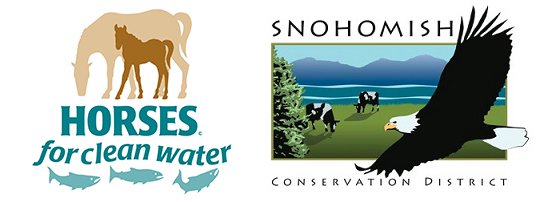Manure management, Insect Control, and Bog Plants on Horse Properties
/by Alayne Blickle, Horses for Clean Water
“My bogs have turned out to be quite a fun and successful addition to our insect control program,” says Tracy Farnham, referring to several containers of bog plants she has on her Snohomish horse property. Tracy’s bog plants are carnivorous, meaning they eat insects.
“Whenever I walk past them, they are buzzing with insects trapped in them.”
Who would have thought that carnivorous bog plants, such as sundews and pitcher plants, would have a place on a horse property?
Pitcher Plants at one corner of the paddocks
Tracy and her husband Adam have three horses on their five acres. To help with managing their property and natural resources they have a farm plan with the Snohomish Conservation District. Having a farm plan means that they are trying to do the best thing for their horses and to be good stewards of the land.
Managing horse manure is part of how they do that. The Farnhams compost the 50 pounds of manure that each of their horses produce per day. All organic matter, including horse manure, eventually will decompose, but composting speeds up the process by providing an ideal environment to put beneficial bacteria, fungi, and other microorganisms to work. As manure and stall waste is broken down, the microorganisms generate a tremendous amount of heat. This heat destroys weed seeds, fly larvae, worm eggs, and other disease-causing pathogens. Finished compost is a crumbly, earthy-smelling, dark material, and a marvelous soil amendment that holds moisture in soils and adds nutrients.
Part of the reason the Farnhams compost manure is because the finished product is a wonderful soil amendment and Tracy and Adam have almost literally spread their entire property with compost. They use the finished compost on lawn and pasture. In fall they spread a thin layer of compost on the garden for the winter.
Another reason the Farnhams compost is that odors and flies are associated with fresh manure and not with the composting process, so by composting they are reducing this insect load. Even so, insect pests, such as flies and mosquitoes still happen. That’s where the Farnham’s bog plants come into play for a little extra help.
“I started indoors with a little terrarium of carnivorous plants,” explains Tracy. Then she discovered that these insect-devouring bog plants do better outside, and that they like full sun. “I thought they might be a good addition to horse paddocks.”
Tracy took whiskey barrels and put pond liners in them to make a more water-tight seal. Because carnivorous bog plants get all the nutrients that they need from the bugs they consume, all they need for a growing medium is low-nitrogen, acidic soil of peat moss mixed with sand and perlite. And no fertilizers! Carnivorous plants require water that is low in minerals, so Tracy uses rainwater, distilled water, or a ZeroWater filter.
Tracy has one bog system at either corner of the horse paddocks, two small ones at the front porches of the house, and a mobile one on wheels in front of the barn. They are each planted with different types of carnivorous bog plants: Venus flytraps, Darlingtonia cobra lily, a variety of American pitcher plants (Sarracenia), and a variety of sundews.
“They are a lot of fun, all the different shapes and sizes,” says Tracy with a smile.
Different bog plants have different mechanisms for capturing and digesting their prey. Pitcher plants lure insects into a cone-shaped area with an interior of slippery sides. The trapped insects slide down the sides into the digestive fluids at the bottom. With Venus flytraps, insects enter it thinking it's a flower, but in reality it enters “the trap.” Its presence stimulates sensitive trigger hairs which cause the leaf blades to snap shut and ensnare the visitor.
“They are all consuming bugs constantly,” Tracy states with pride.
“Everything we grow here needs to have a purpose,” she says. Most of their flowers are in pollinator gardens, which provide a food source for native pollinating insects. Two rain gardens capture and filter runoff from roofs, paddocks, and driveways and allow it to soak back into the footprint of the property via a garden area of native plants.
And now the Farnhams have bog plants for trapping insects. “I assume that they help [with insect control] because of the number of bugs that are in them at all times.”
As a result of their nature-based approach to horse property management, the countryside surrounding the Farnhams property is a bit healthier.
“It’s a work in progress,” says Tracy. “There’s always something more to be done here.”
Contact the Snohomish Conservation District for information on manure management, composting, farm plans, pollinator hedgerows, or rain gardens.
Bog plants growing at the corner of the farnham’s horse paddocks. The chicken wire protects the plants from browsing deer.
This project has been funded wholly or in part by the United States Environmental Protection Agency under assistance agreement PC-01J18001 to the Washington State Department of Health. The contents of this document do not necessarily reflect the views and policies of the Environmental Protection Agency, nor does mention of trade names or commercial products constitute endorsement or recommendation for use.






